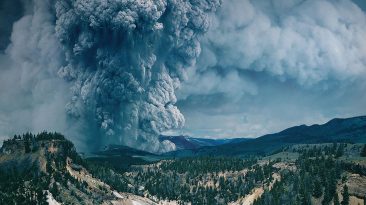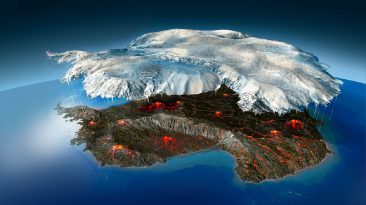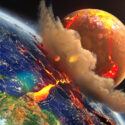In a matter of days, a nearby volcano will erupt, spewing debris and lava, and decimating your city. You know that fighting fire with fire usually makes things worse, but maybe you could fight fire with ice.
What happens when lava suddenly cools down? How much ice would you need? Does adding ice to a volcanic eruption make it better or worse?
You wouldn’t be the first person to try to stop lava by cooling it. Back in 1973, local authorities in Iceland attempted to stop a lava flow by using ice-cold seawater. But 5 billion liters (1.5 billion gallons) of seawater later, they still weren’t able to stop the advancing lava.
At least they managed to divert the flow away from the island’s harbor. So, learning from this past failure, you decide to ramp it up by dropping a giant chunk from an iceberg into the middle of the volcano. Is this a brilliant idea or a horrible mistake?
Before you go dumping an iceberg into your local, active volcano, let’s run a simulation first. Mount Michael, in the South Sandwich Islands, would be a good testing ground. It has a 110 m (360 ft) wide lava lake that bubbles at about 988 ºC to 1,279 ºC (1,812 ºF – 2,334 ºF). And it’s located in a desolate area, so very few life-forms would be in danger.
You’d need a pretty large iceberg to throw into Mount Michael’s lava lake, about the size of one and a half football fields. This sounds massive. But don’t despair because huge icebergs are not that unusual. In 2017, a massive iceberg broke off the east side of Antarctica’s peninsula.
When it first broke off, it was bigger than Luxembourg and 200,000 times larger than Mount Michael’s lava lake. So once you have your iceberg, or chunk of an iceberg, and you drop it into the lava, what would happen? Well, the first thing that you’d see is an immediate blast of steam.
The meeting of these two extremes, ice and lava, would cause the ice to go from its solid state to a gaseous state instantaneously, skipping the liquid form. This is called sublimation. Next, two things could happen.
The ice might turn into steam faster than it can escape, creating a massive steam explosion. This steam would create even more pressure inside the volcano, causing it to explode. Hardened magma, called tephra, would fly through the air. Some of the pieces could be as large as a house.
Uh, yeah, not exactly what you were going for. What about the second possibility? Well, alternatively, the ice could cool the surface temperature of the lava.
The lava would look like it’s boiling as the vapor tries to escape, and it would harden into a texture like Bubble Wrap. Mission accomplished, right? Not exactly. The hard shell would trap volcanic gas.
Over time, pressure from the trapped gas would build until – boom! The volcano blasts its top off. So, instead of stopping a volcanic eruption, dumping an iceberg into an active volcano would make the explosion even worse. Maybe this isn’t the best idea if you need to save your city from an impending volcanic explosion.
Sources
- “What Happens When Lava Comes In Contact With Ice?”. 2018. Science ABC.
- “A-68A Iceberg Thinning At 2.5 Cm Per Day“. 2021. phys.org.
- “Frequently Asked Questions About Mauna Loa Volcano”. 2021. usgs.gov.
- “Mauna Loa”. 2021. usgs.gov.
- “How Do Volcanoes Erupt?“. 2021. usgs.gov.



























